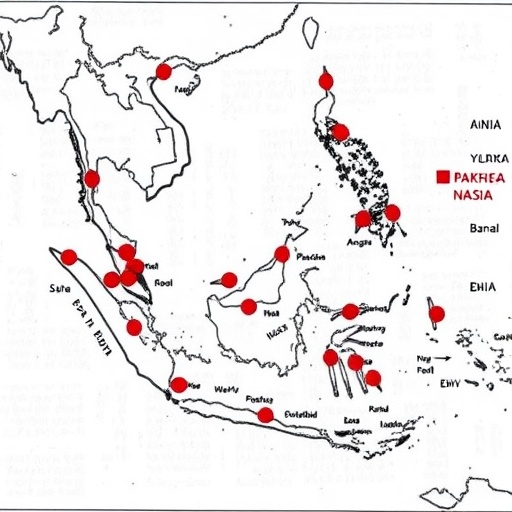In an era marked by rapid advancements in infectious disease research and a growing need to revisit neglected tropical diseases, a comprehensive bibliometric analysis spanning six decades has shed new light on paragonimiasis, a parasitic affliction endemic to Southeast Asia. The study, conducted by Rodriguez and Angeles, delves deep into the evolution, trends, and research dynamics surrounding Paragonimus infections from 1963 to 2023. This analysis offers an unprecedented panoramic view of the scientific community’s engagement with paragonimiasis, charting its trajectory across multiple disciplines and highlighting critical gaps as well as future research avenues.
Paragonimiasis, caused by lung flukes of the genus Paragonimus, represents a complex zoonotic disease predominantly found in freshwater crabs and crustaceans, which serve as intermediate hosts. When humans consume undercooked or raw infected crustaceans, the larvae invade lung tissues, leading to chronic pulmonary symptoms often confused with tuberculosis or cancer. The chronicity and diagnostic obstacles underscore why paragonimiasis poses ongoing challenges in endemic regions, particularly in parts of Southeast Asia where cultural dietary practices and ecological factors converge to sustain its transmission cycle.
Rodriguez and Angeles employed advanced bibliometric techniques to quantify and qualify the academic output on paragonimiasis, utilizing databases indexed since the 1960s. Their analysis incorporated metrics including publication volume, citation networks, authorship patterns, geographic distribution of research, and thematic focus areas. Such an approach not only maps historical trends but elucidates the shift in research priorities aligned with epidemiological changes and technological innovations.
.adsslot_dvqWb9EypC{ width:728px !important; height:90px !important; }
@media (max-width:1199px) { .adsslot_dvqWb9EypC{ width:468px !important; height:60px !important; } }
@media (max-width:767px) { .adsslot_dvqWb9EypC{ width:320px !important; height:50px !important; } }
ADVERTISEMENT
Remarkably, the study identifies several distinct phases in paragonimiasis research. The initial decades from 1960 to 1980 witnessed foundational parasitological research focused on life cycle elucidation, taxonomy, and clinical case reports. This period was characterized by intense field studies and experimental investigations that established the biological underpinnings necessary for subsequent diagnostic and therapeutic advancements.
Entering the 1980s and 1990s, there was a discernible increase in epidemiological studies aiming to quantify disease burden and identify risk factors within affected populations. Public health institutions in endemic nations, often in collaboration with international agencies, spearheaded mass screenings and intervention trials. Papers from this phase reflect growing awareness of paragonimiasis as a formidable public health issue, demanding integrated control strategies.
The turn of the millennium brought technological revolutions that reshaped diagnostics and molecular studies related to paragonimiasis. The bibliometric analysis detects a surge in publications on PCR-based detection, serological assays, and genetic characterization of Paragonimus species. These tools significantly enhanced sensitivity and specificity, facilitating earlier diagnosis and better patient outcomes. Moreover, molecular phylogenetics has refined taxonomic classifications, offering insights into parasite speciation and geographic distribution.
Notably, Rodriguez and Angeles highlight the interdisciplinary nature of recent research, merging parasitology, molecular biology, immunology, and even computational modeling. Studies encompassing host–parasite interactions, immunopathogenesis, and vaccine development have gained prominence. This multidisciplinary engagement reflects the complexity of paragonimiasis and the necessity for holistic approaches to mitigate its impact.
Despite these advances, the analysis reveals persistent challenges. For instance, while diagnostic techniques have improved in laboratory settings, their translation into point-of-care tools for resource-limited endemic areas remains insufficiently addressed. Additionally, global funding for neglected tropical diseases often overlooks paragonimiasis, limiting large-scale intervention programs. The bibliometric data underscore disparities in research output across countries, with Southeast Asian nations leading contributions yet facing infrastructural and financial constraints.
The data also point toward emerging research frontiers. The intersection of climate change with parasitic disease ecology suggests potential shifts in paragonimiasis epidemiology. Temperature and humidity variations may influence intermediate host populations and parasite development cycles, potentially expanding or contracting endemic zones. Early bibliometric signals hint at nascent studies probing these environmental determinants.
Furthermore, increasing human mobility and urbanization pose complex epidemiological scenarios. Urban expansion encroaching on endemic rural habitats could alter transmission dynamics, introducing challenges for traditional control efforts. Research integrating geographic information systems (GIS) and spatial analysis has begun to emerge, mapping hotspots and predicting outbreak risks with greater precision.
Rodriguez and Angeles’ work also sheds light on therapeutic developments. Historically reliant on Praziquantel and Triclabendazole, antiparasitic regimens face potential resistance and variable efficacy. Bibliometric trends reveal growing interest in novel drug candidates and combination therapies, as well as immunomodulatory approaches. These studies are at a nascent stage but represent critical endeavors toward sustainable disease management.
The analysis additionally underscores the importance of community engagement and health education. Behavioral interventions aimed at modifying dietary and cooking practices are pivotal in breaking transmission cycles. Papers documenting community-based participatory research and culturally tailored interventions suggest a shift toward integrated control frameworks that blend biomedical, ecological, and sociocultural dimensions.
Importantly, the bibliometric findings emphasize collaborative networks among researchers and institutions as drivers of innovation. Co-authorship patterns reveal clusters of expert groups and regional centers of excellence, fostering knowledge exchange and capacity building. International partnerships have facilitated resource sharing, training, and large-scale epidemiological surveys, bolstering the global response to paragonimiasis.
This 60-year bibliometric portrait not only commemorates the progress made but serves as a clarion call to reinvigorate research efforts against paragonimiasis, a disease that has lingered in relative obscurity despite its substantial health burden. The comprehensive mapping provided by Rodriguez and Angeles equips policymakers, funding agencies, and researchers with data-driven insights to strategize future priorities, allocate resources efficiently, and ultimately reduce the disease’s toll.
In essence, paragonimiasis research encapsulates the evolution of parasitology and tropical medicine from foundational biological explorations to integrative, technology-driven inquiry. The longitudinal bibliometric trajectory reflects the shifting paradigms in disease understanding and control measures. As Southeast Asia continues to bear the brunt of this neglected parasitosis, sustained research momentum and cross-sectoral collaboration will be crucial in transforming decades of knowledge into tangible health gains for affected communities.
With scientific curiosity and technological innovation driving this field forward, the hope remains that paragonimiasis will transition from a neglected affliction to a controllable condition with minimized human suffering. This bibliometric lens therefore provides both a retrospective understanding and a prospective roadmap, inspiring renewed dedication to tackling one of Southeast Asia’s enduring tropical health challenges.
Subject of Research: Paragonimiasis, a parasitic disease caused by lung flukes, endemic in Southeast Asia.
Article Title: Paragonimiasis in Southeast Asia: A 60-Year Bibliometric Analysis (1963–2023).
Article References:
Rodriguez, H.M., Angeles, J.M.M. Paragonimiasis in Southeast Asia: A 60-Year Bibliometric Analysis (1963–2023).
Acta Parasit. 70, 149 (2025). https://doi.org/10.1007/s11686-025-01085-0
Image Credits: AI Generated
Tags: academic output on tropical diseasesbibliometric analysis of paragonimiasischronic pulmonary symptoms diagnosticscultural dietary practices and healthenvironmental factors in disease transmissionepidemiology of lung fluke infectionsfuture research directions in paragonimiasislung flukes and human healthneglected tropical diseases in Southeast Asiaparagonimiasis research trendsSoutheast Asia infectious diseaseszoonotic diseases and transmission






